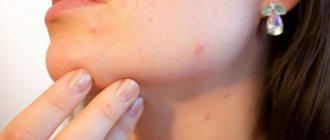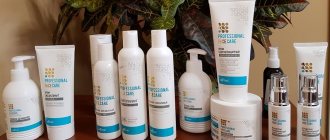How do vitamins affect facial skin?
They are important for skin health as they perform the following functions:
- activate metabolic processes;
- strengthen local immunity, help resist aggressive environmental factors;
- participate in the production of collagen, increasing the elasticity and smoothness of the epidermis.
The following symptoms will indicate a lack of nutrients:
- peeling;
- itching;
- rashes and blackheads**;
- dull color;
- flabbiness.
Interestingly, the body can respond to a lack of vitamins both by dryness of the epidermis and by activating the sebaceous glands.
Despite such an important role of vitamins for facial skin, they will help against acne* for teenagers and adults only in combination with anti-acne medications, for example, Azelik® gel. You can buy the medicine at the pharmacy; it is suitable for treating mild to moderate acne. It can be used from 12 years old.5,9
You should always trust acne treatment to a specialist. After conducting a diagnosis, he will be able to determine whether the rash is caused by a deficiency of nutrients.
Introduction
Acne is a chronic inflammatory disease of the pilosebaceous apparatus, which is equally observed in both sexes.
It is estimated that 75–95% of all adolescents suffer from acne to some degree [1]. This disease is characterized by non-inflammatory (white and black comedones) and inflammatory lesions (papules, pustules, nodules and/or cysts), which can negatively affect patients both psychologically and cosmetically due to the processes of scarring and pigmentation [2]. Acne has a multifactorial pathogenesis. There is follicular hyperkeratinization, colonization by Cutibacterium acnes (formerly known as Propionibacterium acnes) with subsequent inflammation. Acne is localized in areas with the largest number of sebaceous glands - mainly the face, back, chest and shoulders. Classification is important and helps in choosing treatment options [4].
Acne is classified according to severity as mild, moderate and severe. Typical mild acne lesions are characterized by the presence of closed and open comedones with a small amount of inflammatory elements and are limited to the facial area. Whereas with moderate acne, increased inflammation is observed with a large number of papules and pustules on the face.
The torso area may also be affected. Finally, the presence of nodules and cysts is a sign of severe acne. This is characterized by widespread damage to the torso area along with damage to the face. Vitamin D is a fat-soluble steroid hormone obtained from food and synthesized through the skin upon exposure to sunlight.
Vitamin D3 (cholecalciferol) and vitamin D2 (ergocalciferol) are produced by exposure to ultraviolet B radiation from the sun. Absorption of UV radiation by the skin leads to the conversion of provitamin D to pre-vitamin D, followed by the formation of vitamin D [3,6].
To assess vitamin D deficiency and insufficiency, serum 25-(OH)-D concentration is used as a biomarker. Due to its short half-life of approximately 15 hours, 1,25-(OH)-2D levels are not considered a good laboratory marker for determining vitamin D levels. In contrast, 25(OH)-D is more stable in the blood than 1. 25-(OH)-2D. Blood concentrations of 25(OH)-D are 500–1000 times higher than 1,25(OH)2D levels [7].
Vitamin D also affects the immune system. In addition, it regulates the proliferation and differentiation of keratinocytes and sebocytes. In addition, vitamin D has antioxidant and anti-comedogenic properties. Thus, vitamin D deficiency may contribute to the formation of acne. We aim to evaluate serum vitamin D [25(OH)D] levels in patients with acne and investigate the possibility of an existing relationship between low serum vitamin D levels and acne severity. To the best of our knowledge, such a study is believed to be the first in the Kingdom of Saudi Arabia.
Materials and methods
The study was conducted in the outpatient dermatology clinics of Qassim University, Saudi Arabia, between October 2016 and March 2022. It was approved by the local medical ethics committee of Qassim University College of Medicine and was in accordance with the Declaration of Helsinki.
The study was conducted during the winter season to minimize the effect of seasonal variations on serum vitamin D levels. The study included 68 patients with acne vulgaris (27 men and 41 women) and 50 healthy controls (24 men and 26 women). All patients in the study and control groups did not take any vitamin D supplements and did not suffer from any comorbidities with vitamin D deficiency.
Both groups underwent complete physical and clinical examinations and biochemical tests for serum vitamin D levels. Each study subject signed written informed consent and received a detailed explanation of the purposes and steps of this study.
Acne was classified as mild, moderate, or severe. Mild grade was considered to be <20 comedones, <15 inflammatory lesions, or total number of pathological elements <30. The average degree was characterized as the presence of 20–100 comedones, 15–50 inflammatory foci, or a total number of pathological elements of 30–125. Severe acne > 5 pseudocysts, total number of comedones > 100, total number of inflammatory elements > 50 or total number of pathological elements > 125) [9].
All 68 subjects completed questionnaires to demonstrate data on: family history of acne, sun exposure >2 hours per day, age of onset, duration of disease, location of acne (face, chest, and back), medical history, and other important variables.
Inclusion criteria
Male and female patients diagnosed with acne according to the Global Acne Score 6t English. global acne grading system, GAGS).
Non-inclusion criteria
Pregnant, breastfeeding, patients taking oral contraceptive pills, postmenopausal patients, patients taking corticosteroids or any medications that affect the metabolism of vitamin D (ketoconazole, rifampicin, phenytoin, isoniazid).
Patients taking vitamin D supplements, multivitamins. Patients suffering from active malignancy or other chronic systemic diseases. Patients regularly taking medications for other diseases, as well as patients who have taken isotretinoin orally within the past 3 months.
Lab tests
Study participants had their serum concentrations of 25-hydroxyvitamin D3 [25(OH)D] measured. Blood samples were collected from veins and analyzed within 24 hours of collection using a Roche Cobas e411 (Roche Diagnostics System, Switzerland). According to the recommendations of the Food and Nutrition Board of the Institute of Medicine, serum 25(OH)D levels were categorized as adequate (>20 ng/mL), reduced (12–20 ng) / ml) and deficiency (< 12 ng / ml) [10].
Statistical analysis
The recorded data were analyzed using specialized software 20.0 SPSS Inc., (Chicago, IL, USA). Analysis of variance (ANOVA) was performed. A significance level of p = 0.001 was considered significant, and p = 0.05 was considered insignificant.
results
This study included 68 patients with acne (41 women and 27 men) and 50 healthy controls (26 women and 24 men). Baseline demographic and clinical characteristics of participants are presented in Table 1. Acne patients were younger than control participants. Fourteen acne patients (20.5%) and twelve healthy subjects (24%) were exposed to sunlight for an average of more than two hours per day (Table 1).
Laboratory results
Vitamin D concentration [25(OH)D]
There is a statistical difference between the serum concentrations of vitamin D [25(OH)D] of the two groups. Vitamin D levels were higher in healthy subjects than in patients with acne (p = 0.003) (Table 2). In addition, we did not determine a significant relationship between sun exposure (Fig. 1), gender and serum vitamin D [25(OH)D] concentration in patients with acne vulgaris (p = 0.199) (Table 3).
Although there was moderate statistical significance between males and females in the healthy control group (p value = 0.042) (Table 4). The study results showed that there was no association between serum vitamin D concentrations and acne severity (mild, moderate, and severe) in subjects in the study groups (p = 0.067) (Table 5). In addition, we found no significant differences between gender and serum vitamin D concentrations, or between mild, moderate, and severe acne severity (p = 0.349, 0.291, and 0.572, respectively) (Tables 6–8).
Discussion
To the best of our knowledge, this is the first such study in Saudi Arabia to evaluate serum vitamin D levels in patients with acne. There are several biological mechanisms by which vitamin D exerts its anti-inflammatory effects. These mechanisms support the theory of the immunoregulatory function of vitamin D and its anti-inflammatory effect in patients with acne. Vitamin D suppresses Th17 differentiation induced by Cutibacterium acne. Indeed, interleukin 17 (IL-17) is an inflammatory cytokine whose levels are elevated in patients with acne. Vitamin D reduces the expression of IL-17 [11].
In cultured sebocytes, vitamin D also reduces the expression of inflammatory cytokines such as IL-6, IL-8 and matrix metalloproteinase [9,12]. Other mechanisms contribute to the antimicrobial effect by inducing antimicrobial peptides, such as LL-37, in human sebocytes [13]. Our results showed that serum vitamin D concentrations in subjects in the control group were significantly higher than those in acne patients (p = 0.003). These results are consistent with several other studies that have shown that patients with acne do not experience increased serum vitamin D levels [8,14,15]. Since the purpose of the study is to analyze vitamin D levels in acne patients, our results showed that there was no association between sun exposure and improvement in vitamin D levels in acne patients (p = 0.546). This could possibly be explained by several factors, such as the effects of psychological stress and subjects' reluctance to spend long periods outdoors. This finding suggests a possible explanation for low vitamin D levels in acne patients.
Our results are consistent with those of Lim et al, who showed that lower serum vitamin D levels in patients with severe acne may be caused by psychological stress. Another factor in vitamin D deficiency is environmental factors such as the hot climate of Saudi Arabia and the Persian Gulf, especially in summer. Again, our results are similar to those of Al-Taiar et al., who shed light on vitamin D deficiency among adolescents despite abundant sunshine in the Gulf [16].
The same results were obtained in another study by Elmohsen et al. in Egypt. Scientists in this study found no significant association between sun exposure and increased serum vitamin D levels. This supports our view that environmental factors, such as the very hot climate in Arab countries, may contribute to a reduction in the likelihood and duration of sun exposure.
Among our patients, we did not find a significant association between vitamin D deficiency and gender (p = 0.199). Our results are similar to those of several studies [14,15,17,18]. The results of the current study showed that the mean vitamin D value was higher in moderate acne (31.4 ± 6.9) than in mild and severe acne (26 ± 9.4 and 28.4 ± 6.7, respectively) .
However, this difference was not statistically significant (p = 0.067). However, this may be explained by the small sample size of our study. Additionally, we did not find a significant association between vitamin D deficiency and acne vulgaris severity. This result is consistent with several other studies [8,19].
Conclusion
This study found statistically significant low serum vitamin D levels in patients with acne. This finding highlights the importance of screening patients with acne for vitamin D insufficiency and deficiency. Further large-scale clinical trials are needed to elucidate the importance of vitamin D in acne.
The authors suggest a possible role for vitamin D treatment in acne. Further clinical trials are required to determine the effectiveness of both topical vitamin D analogues and oral vitamin D supplements in treating acne.
Table 1. Demographic and clinical data of patients with acne and control participants
| Indicators | Acne patients (68) | Control group (50) |
| Floor Men Women | 27 (39.7%) 41 (60.3%) | 24 (48%) 26 (52%) |
| Age (years) | ||
| Male (mean ± SD) Female (mean ± SD) | 20.7±3.8 21.3±3.6 | 39.8±11.8 37.7±14.85 |
| Solar exposure ˃2 hours per day N (%) | 14 (20.5%) | 12(24%) |
| Family history of acne N (%) | 29(42.65%) | N.A. |
| Age of onset of disease, years | 16.55±4.99 | N.A. |
| Duration of disease, years (mean ± SD) | 4.8±0.8 | N.A. |
| Localization of acne Face N (%) Chest N (%) Back N (%) | 68(100%) 24(35.3%) 40(54.41) | N.A. |
| Disease severity Mild N (%) Average N (%) Heavy N (%) | 21 (30,88%) 26 (38,24%) 21 (30,88%) | N.A. |
Abbreviations: N, number; SD, standard deviation; %, percent; NA, not specified.
Table 2. Comparison of serum vitamin D levels in patients with acne and controls
| Indicators | Acne patients (68) | Control group (50) | p-value |
| Serum vitamin D level ng/ml (mean ± standard deviation) | 28.8±7.9 | 40±11.7 | 0.003** |
Note: **Significant differences P ≤ 0.005.
Table 3. Relationship between serum vitamin D levels and gender in patients with acne
| Indicators | Male patients with acne (27) | Female patients with acne (41) | p-value |
| Serum vitamin D level ng/ml (mean ± standard deviation) | 30.39±7.9 | 27.8±7.8 | 0.199 |
Table 4. Relationship between serum vitamin D levels and gender in control subjects
| Indicators | Men (24) | Women (26) | p-value |
| Serum vitamin D level ng/ml (mean ± standard deviation) | 36.3±10.26 | 29.3±12.2 | 0.042** |
Note: **Significant differences P ≤ 0.005.
Table 5. Relationship between serum vitamin D levels and acne severity .
| Indicators | Light (21) | Medium (26) | Heavy (21) | p-value |
| Serum vitamin D level ng/ml (mean ± standard deviation) | 26±9.4 | 31.4±6.9 | 28.4±6.7 | 0.067 |
Table 6. Relationship between serum vitamin D levels and gender in patients with mild acne .
| Indicators | Male patients with mild acne (8) | Female patients with mild acne (13) | p-value |
| Serum vitamin D level ng/ml (mean ± standard deviation) | 28.8±7.9 | 24±8.3 | 0.349 |
Table 7 . Relationship between serum vitamin D levels and gender in patients with moderate acne.
| Indicators | Male patients with moderate acne (8) | Female patients with moderate acne (18) | p-value |
| Serum vitamin D level ng/ml (mean ± standard deviation) | 33.6±6.9 | 30.4±6.8 | 0.291 |
Table 8. Relationship between serum vitamin D levels and gender in patients with severe acne
| Indicators | Male patients with severe acne (11) | Female patients with severe acne (10) | p-value |
| Serum vitamin D level ng/ml (mean ± standard deviation) | 29.2±5.7 | 27.5±7.9 | 0.572 |
What vitamins are needed for facial skin to get rid of acne*?
Here are the vitamins you need to improve your facial skin and get rid of acne*218:
- A – vitamin analogues are synthetic retinoids that are used to treat acne. In addition, it slows down the aging process, suppresses the sebaceous glands, reducing sebum production.
- B – here we are talking about a whole complex of good vitamins. B6 has an anti-inflammatory effect. B3 helps tighten pores, reduce sebum production, and strengthens local immunity. B5 promotes tissue restoration and renewal. B9 also has an anti-inflammatory effect and enhances skin protection.
- C is a powerful antioxidant. Protects against solar radiation, helps lighten hyperpigmentation, and participates in collagen production.
- D and E - accelerate regenerative processes, increase skin tone, improve the functioning of the nervous and immune systems, and have an antioxidant effect.
- K – helps fight edema and post-inflammatory hyperpigmentation.
A vitamin complex for facial skin against acne* should only be selected by a specialist. Their uncontrolled use can lead to even more rashes, redness, and peeling.
Vitamin B. Hypervitaminosis
Symptoms
Taking into account the above features of the metabolism of B vitamins, one could assume a statistical predominance of one-time, acute overdoses caused by more or less random intake of concentrated drugs in large volumes.
However, if we add psychological (self-prescribed treatment and prevention) and iatrogenic (inadequate dosages of vitamin therapy prescribed by a doctor) to the biochemical nuances, a significant proportion of chronic hypervitaminosis B also becomes clear. The vast majority of such cases are overdoses of B1, B3, B5, B6, B9 and B12. The most typical and common symptoms are increased excitability, emotional instability, tachycardia, headaches, nausea, redness of the skin, dyssomnia (certain sleep disorders).
Vitamin B1 (thiamine) in excess doses can cause anaphylactic shock, skin reactions such as urticaria and increased photosensitivity, kidney and liver dysfunction.
Vitamin B3 (niacin, vitamin PP, nicotinic acid) in overdose causes, in addition to the above-mentioned symptom complex, severe dyspepsia, dizziness, itching and paresthesia (false tactile sensations), muscle pain, cardiovascular disorders (high blood pressure in a standing position).
Acute hypervitaminosis B5 (pantothenic acid) can, among other things, cause dehydration.
Overdose of B6 (adermine, pyridoxine) – atactic phenomena in the form of impaired coordination of movements, confusion, convulsions, increased acidity of gastric secretions.
Hypervitaminosis B9 (folic acid) – cramps in the lower extremities, allergic reactions. In addition, in 2016 , the results of a study conducted by employees of the Johns Hopkins Institute (USA) on medical and statistical data for the period 1998-2013 were published. It has been shown that unreasonable and deliberately excessive consumption of folic acid and cobalt-containing vitamins B12 by pregnant women (and the importance of these vitamins during gestation is well known) increases the risk of autism in children by 2-3 times, especially if “hyperprophylaxis” occurred in the third trimester. In addition, B12 increases blood clotting and, accordingly, the risk of blood clots. In general, the results of the study make us think seriously and once again raise the question of the feasibility, the need for the most careful monitoring, taking into account all indications and contraindications for vitamin therapy and vitamin prophylaxis during pregnancy: in many cases, the optimal level of con in the blood was exceeded by 15-17 or more times . The most severe complications of hypervitaminosis B include renal and liver failure, steatohepatosis, pulmonary edema, anaphylactic shock, exacerbation of gastroenterological and cardiac diseases.
It is interesting to note that the clinical picture of hypervitaminosis B is largely reminiscent or even repeats the symptoms of hypovitaminosis.
Vitamins in nutrition: what to eat to avoid acne
Dermatologists say that one of the most numerous causes of acne is dietary errors. The appearance of acne is promoted by a passion for sweet, fatty, starchy foods. Salty dishes and marinades, smoked foods, and alcohol do not contribute to the beauty of the skin. At the same time, the best natural vitamins for acne are found in the following products:
- Porridge. Buckwheat, oatmeal, rice, pearl barley, millet are rich sources of fiber, which significantly improves intestinal functioning. This has a beneficial effect on the condition of the skin.
- Fermented milk products are rich in B vitamins, ascorbic acid, beta-carotene and retinol. Regular consumption of cottage cheese, yogurt, kefir, fermented baked milk and sour cream helps avoid the need to undergo treatment with vitamins in ampoules or tablets.
- Sea fish. Salmon, pink salmon, and salmon are irreplaceable sources of polyunsaturated fatty acids, which are extremely important for clear skin.
- Pumpkin seeds and their oil. This product is a natural concentrate of zinc - a substance that helps cope with acne and pimples.
- Green tea. The drink contains antiseptic compounds, so drinking tea helps remove inflammation on the skin.
- Vegetables and fruits. These are sources of vitamins and minerals that help improve the condition of skin, hair and nails.
All the products listed above are useful not only for women, but also for men. Proper nutrition, of course, does not guarantee that the need for vitamin therapy will disappear. In some cases, only vitamins in ampoules prescribed by a doctor will save you from acne. However, in any case, it is possible to get rid of acne. You just have to want it.
Website www.sympaty.net – Beautiful and Successful. Author: Elena Burenyuk. More information about the site's authors











